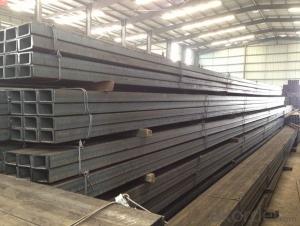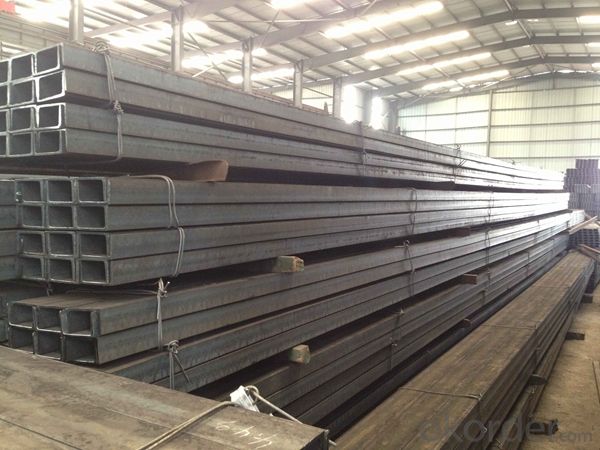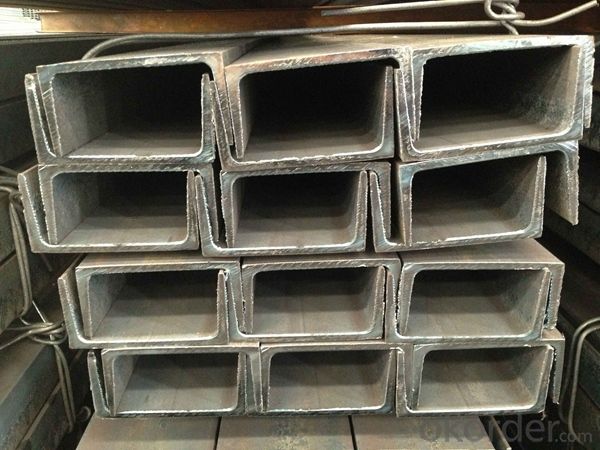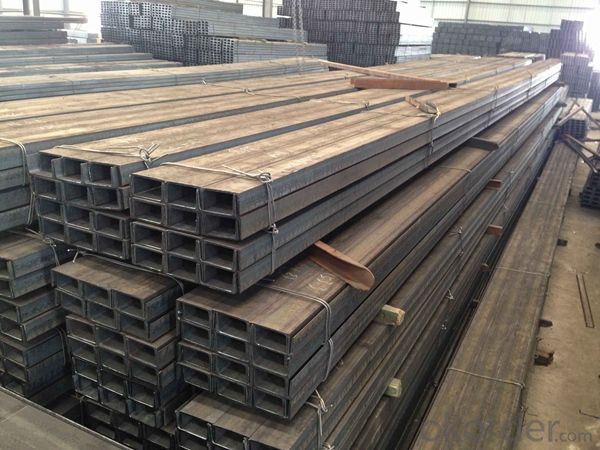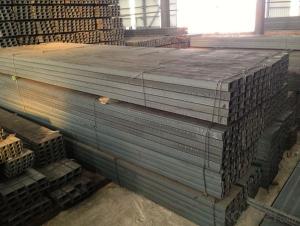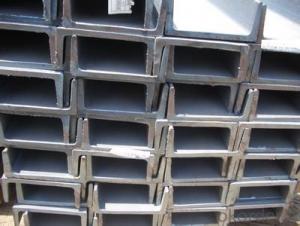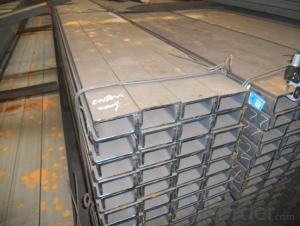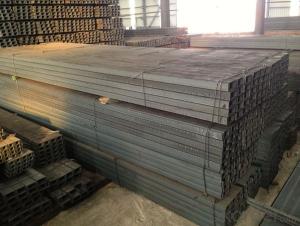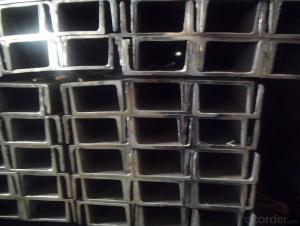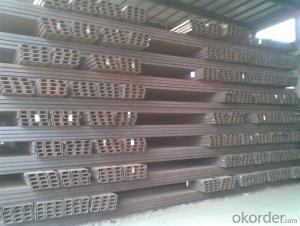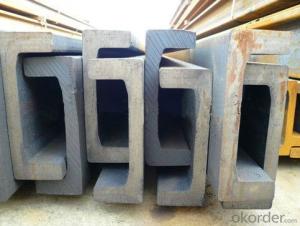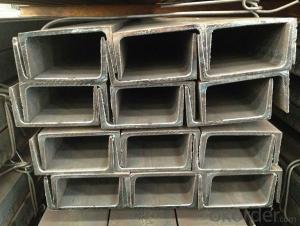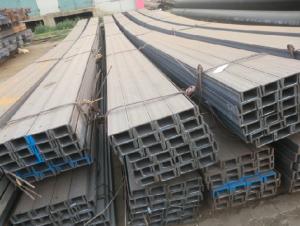Hot Rolled MS Mild GB Steel U Channels for Strcutures
- Loading Port:
- Shanghai
- Payment Terms:
- TT OR LC
- Min Order Qty:
- 25 m.t.
- Supply Capability:
- 200000 m.t./month
OKorder Service Pledge
OKorder Financial Service
You Might Also Like
Product Description:
OKorder is offering Hot Rolled MS Mild GB Steel U Channels for Strcutures at great prices with worldwide shipping. Our supplier is a world-class manufacturer of steel, with our products utilized the world over. OKorder annually supplies products to European, North American and Asian markets. We provide quotations within 24 hours of receiving an inquiry and guarantee competitive prices.
Product Applications:
Hot Rolled MS Mild GB Steel U Channels for Strcutures are ideal for structural applications and general fabricating. The steel u channel can be applied to construction of warehouses, workshops, sport stadiums and car parks etc. In details, the steel u channel belongs to carbon structural steel which is applied to in the field of construction and machinery. The steel u channel is usually used for arch-itechtural structure, and they could be welded in order to support or hang a vari-ety of facilities. They are also usually used in combination with I beam. Generally,the steel u channel must possess perfect welding property, riveting property and mechanical property and so on.
Product Advantages:
Hot Rolled MS Mild JIS Steel U Channels for Strcutures are durable, strong, and resists corrosion.
Main Product Features:
· Premium quality
· Prompt delivery & seaworthy packing (7-10 days after receiving deposit)
· Corrosion resistance
· Can be recycled and reused
· Mill test certification
· Professional Service
· Competitive pricing
Product Specifications:
1.We supply high quality MS Channel at reasonable price, including Chinese standard, Japanese standard and so on.
Standard | GB/JIS |
Material Grade | Q235,SS400 |
Technique: | Hot Rolled |
Sizes as per chinese standard: | 50*37*4.5mm - 300*89*11.5mm |
Sizes as per japanese standard: | 50*25*3mm – 200*80*7.5mm |
Length: | 6meter, 9meter, 12meter |
Note: 1.we are also competent to provide our customers other MS Channel based on other sizes according to customer’s requirements.
2. The length of our ms channel could be cut into other meters as per customer’s requirements. For example, the channel in 6meters could be cut into 5.8meters in order to be fit in the 20ft container.
2. The detailed sections of MS Channel as per GB standard.are shown in the table-1:
GB U CHANNEL | Standard | Sectional | Dimension |
| Mass: |
(mm) | (mm) | (mm) | (mm) | ||
50X37 | 50 | 37 | 4.50 | 7.0 | 5.438 |
63X40 | 63 | 40 | 4.80 | 7.5 | 6.634 |
80x43 | 80 | 43 | 5.00 | 8.0 | 8.045 |
100x48 | 100 | 48 | 5.30 | 8.5 | 10.007 |
120x53 | 120 | 53 | 5.50 | 9.0 | 12.059 |
140x58 | 140 | 58 | 6.00 | 9.5 | 14.535 |
140x60 | 140 | 60 | 8.00 | 9.5 | 16.733 |
160x63 | 160 | 63 | 6.50 | 10.0 | 17.240 |
160x65 | 160 | 65 | 8.50 | 10.0 | 19.752 |
180x68 | 180 | 68 | 7.00 | 10.5 | 20.174 |
180x70 | 180 | 70 | 9.00 | 10.5 | 23.000 |
200x73 | 200 | 73 | 7.00 | 11.0 | 22.637 |
200x75 | 200 | 75 | 9.00 | 11.0 | 25.777 |
220x77 | 220 | 77 | 7.00 | 11.5 | 24.999 |
220x79 | 220 | 79 | 9.00 | 11.5 | 28.453 |
250x78 | 250 | 78 | 7.00 | 12.0 | 27.410 |
250x80 | 250 | 80 | 9.00 | 12.0 | 31.335 |
250x82 | 250 | 82 | 11.00 | 12.0 | 35.260 |
280x82 | 280 | 82 | 7.50 | 12.5 | 31.427 |
280x84 | 280 | 84 | 9.50 | 12.5 | 35.823 |
280x86 | 280 | 86 | 11.50 | 12.5 | 40.219 |
300x85 | 300 | 85 | 7.50 | 13.5 | 34.463 |
300x87 | 300 | 87 | 9.50 | 13.5 | 39.173 |
300x89 | 300 | 89 | 11.50 | 13.5 | 43.883 |
Table-1
3. The chemical composition of HR Channel Steel according to Q235B is shown in Table-2.
Alloy No | Grade | Element(%) | ||||
C | Mn | S | P | Si | ||
Q235 | B | 0.12-0.20 | 0.3-0.7 | ≦0.045 | ≦0.045 | ≦0.3 |
Table-2
Note: we are able to present our customers relevant SGS test report for chemical composition of HR Channel Steel.
4. The mechanical property of HR Channel Steel according to Q235B is shown in Table-3-1 and Table-3-2
Alloy No | Grade | Yielding Strength Point(Mpa) | |||
Thickness(mm) | |||||
≦16 | >16-40 | >40-60 | >60-100 | ||
≧ | |||||
Q235 | B | 235 | 225 | 215 | 205 |
Table-3-1
Alloy No | Grade | Tensile Strength(Mpa) | Elongation After Fracture(%) | |||
Thickness(mm) | ||||||
≦16 | >16-40 | >40-60 | >60-100 | |||
≧ | ||||||
G235 | B | 375-500 | 26 | 25 | 24 | 23 |
Table-3-2
Note: we are able to present our customers relevant SGS test report for mechanical property of MS Channel as customer’s request.
FAQ:
Q1: Why buy Materials & Equipment from OKorder.com?
A1: All products offered byOKorder.com are carefully selected from China's most reliable manufacturing enterprises. Through its ISO certifications, OKorder.com adheres to the highest standards and a commitment to supply chain safety and customer satisfaction.
Q2: How do we guarantee the quality of our products?
A2: We have established an advanced quality management system which conducts strict quality tests at every step, from raw materials to the final product. At the same time, we provide extensive follow-up service assurances as required.
Q3: How soon can we receive the product after purchase?
A3: Within three days of placing an order, we will begin production. The specific shipping date is dependent upon international and government factors, but is typically 7 to 10 workdays.
Q4: What makes stainless steel stainless?
A4: Stainless steel must contain at least 10.5 % chromium. It is this element that reacts with the oxygen in the air to form a complex chrome-oxide surface layer that is invisible but strong enough to prevent further oxygen from "staining" (rusting) the surface. Higher levels of chromium and the addition of other alloying elements such as nickel and molybdenum enhance this surface layer and improve the corrosion resistance of the stainless material.
Q5: Can stainless steel rust?
A5: Stainless does not "rust" as you think of regular steel rusting with a red oxide on the surface that flakes off. If you see red rust it is probably due to some iron particles that have contaminated the surface of the stainless steel and it is these iron particles that are rusting. Look at the source of the rusting and see if you can remove it from the surface.
Images:
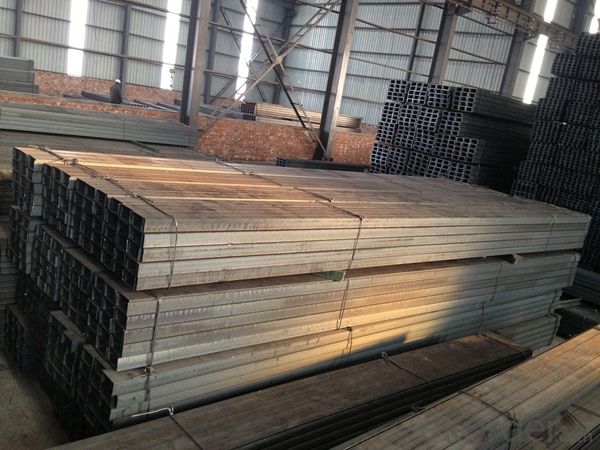
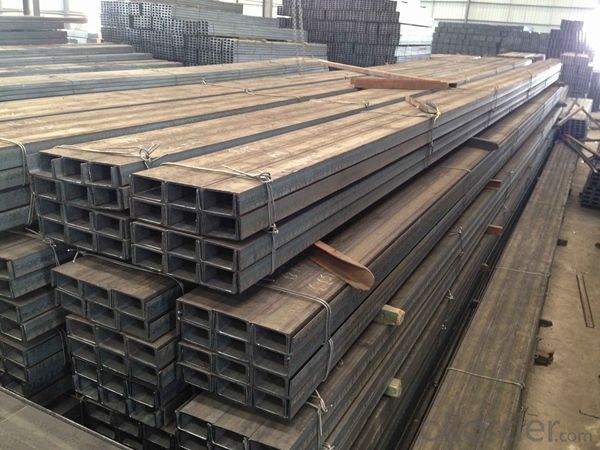
- Q: Can steel channels be used for pipe supports?
- Yes, steel channels can be effectively used for pipe supports. Steel channels have high strength and durability, making them ideal for providing support to pipes. They can be easily fabricated to desired lengths and shapes, allowing for customized pipe support systems. Additionally, steel channels offer excellent load-bearing capacity, ensuring the stability and safety of the pipes. They are resistant to corrosion, which is crucial in environments where pipes are exposed to moisture or harsh chemicals. Overall, steel channels are a reliable and cost-effective choice for pipe supports.
- Q: What are the different types of steel channel connections for door frames?
- Door frames commonly utilize various types of steel channel connections, including welded connections, bolted connections, riveted connections, corner brackets, and adjustable connections. The most prevalent method for steel channel door frames is welded connections. This involves welding the steel channels together at the corners to create a robust and secure frame. Alternatively, bolted connections are frequently employed. This approach entails drilling holes in the channels and inserting bolts to fasten the frame. This type of connection allows for convenient disassembly and reassembly, if necessary. Riveted connections are also utilized in steel channel door frames. This method involves drilling holes in the channels and inserting rivets to hold them together. Riveted connections offer a resilient and long-lasting connection. In some instances, corner brackets may be used to connect the steel channels. Made of steel, these brackets are affixed to the corners of the channels using screws or bolts. Corner brackets provide additional stability and strength to the door frame. Certain steel channel door frames may feature adjustable connections. These connections facilitate easy adjustment of the frame during installation to ensure it is level and plumb. Typically, screws or bolts are used to hold the channels in place, allowing for flexibility in positioning. Ultimately, the choice of steel channel connection for a door frame depends on various factors, including project requirements, desired strength and stability, and ease of installation and maintenance.
- Q: How do steel channels contribute to the stability of structures?
- Steel channels play a crucial role in enhancing the stability of structures through several means. To begin with, they offer structural support by evenly distributing the load along their length, thereby preventing excessive stress or strain on any specific section of the structure. This, in turn, greatly improves the overall stability of the structure. Moreover, steel channels find extensive application as beams or columns in construction. As beams, they bear the weight of the structure and transmit it to the foundation, ensuring that the structure remains stable and does not collapse under the imposed loads. In the role of columns, steel channels provide vertical support, effectively preventing the structure from buckling or bending under compression forces. Additionally, steel channels can serve as braces, further bolstering the stability of a structure. These braces, which are diagonal members connecting different parts of the structure, enhance its resistance to lateral forces like wind or earthquakes. By adding rigidity and stiffness, steel channels help reduce the risk of structural failure or collapse during such events. Furthermore, steel channels possess exceptional strength and durability, making them exceedingly suitable for supporting heavy loads and enduring extreme conditions. Their resistance to corrosion and deterioration guarantees the long-term stability of the structure. Furthermore, steel channels boast a high load-carrying capacity, enabling the construction of larger and more intricate structures that enjoy heightened stability. In conclusion, steel channels play a significant role in enhancing the stability of structures by providing structural support, evenly distributing loads, bearing weight, preventing buckling or bending, serving as braces, and offering exceptional strength and durability. Their incorporation in construction projects significantly enhances the overall stability and safety of buildings, bridges, and other structures, ensuring their sustained existence and ability to withstand various external forces.
- Q: Can steel channels be used for balcony supports?
- Certainly! Balcony supports can indeed utilize steel channels. In the realm of construction and engineering, steel channels are a popular choice due to their robustness and longevity. They offer exceptional structural reinforcement and are particularly well-suited for balconies. By employing adequate design and installation techniques, steel channels can effectively withstand the weight and burden of a balcony, ensuring its steadfastness and security. It is essential to seek guidance from a structural engineer or an experienced contractor to identify the precise dimensions and specifications of the steel channels needed for a given balcony design and load necessities.
- Q: How do steel channels contribute to the overall sustainability of a project?
- There are multiple ways in which steel channels contribute to the overall sustainability of a project. To begin with, steel is an incredibly durable and long-lasting material, meaning that steel channels can withstand the test of time and require minimal maintenance or replacement. As a result, the overall resource consumption and waste generation associated with a project are reduced. In addition, steel channels are recyclable, allowing them to be melted down and reused once they reach the end of their lifespan. This helps to decrease the demand for raw materials and the energy required for manufacturing new steel products, thereby reducing the environmental impact of a project. Moreover, steel channels possess the unique combination of being lightweight and strong, making them ideal for efficient design and construction. Consequently, material usage and transportation costs are reduced, as well as energy consumption during the construction phase. This aspect of steel channels contributes to the overall sustainability of a project by minimizing the carbon footprint and resource depletion associated with the construction process. Furthermore, steel is a non-combustible material, making it a safe choice for projects in terms of fire resistance. This enhances the overall safety and resilience of the project, reducing the risk of damage or destruction and minimizing the need for repairs or reconstruction. Lastly, steel channels offer great versatility in design and construction, enabling innovative and efficient solutions. This flexibility empowers architects and engineers to optimize the use of materials, space, and energy, resulting in sustainable and eco-friendly designs. Overall, steel channels contribute to the overall sustainability of a project through their durability, recyclability, lightweight yet strong properties, fire resistance, and design versatility. By selecting steel channels, project developers can minimize resource consumption, waste generation, carbon emissions, and overall environmental impact, making their project more sustainable in the long run.
- Q: Can steel channels be used for access platforms?
- Access platforms can indeed utilize steel channels. The construction of access platforms often involves the utilization of steel channels, owing to their robustness and long-lasting nature. These channels offer a solid foundation for supporting and safeguarding the platform, guaranteeing the well-being of workers when reaching elevated regions. The adaptability of steel channels allows for tailoring and adjustment to various platform designs and needs. Furthermore, the ease of welding or bolting steel channels together makes them a convenient option for the construction of access platforms.
- Q: How do steel channels perform under static loads?
- Steel channels, commonly utilized in construction and engineering applications, serve as structural components. Their performance proves outstanding when subjected to static loads, such as the weight of structures or equipment resting upon them. One notable advantage of steel channels lies in their impressive strength-to-weight ratio. Despite being relatively lightweight, they possess the ability to support heavy loads. Steel, renowned for its exceptional strength and durability, showcases these qualities in the performance of steel channels under static loads. Moreover, steel channels exhibit good resistance against deformation and deflection. When a static load is applied, these channels evenly distribute the load and resist bending or sagging. As a result, the stability and integrity of the supported structure or equipment remain intact. Additionally, steel channels boast high resistance to corrosion and environmental factors. This renders them suitable for various conditions, including outdoor and industrial environments. Furthermore, their corrosion resistance contributes to their longevity and low maintenance requirements. Aside from their mechanical properties, steel channels can be effortlessly fabricated and installed. They are available in a wide array of sizes and dimensions, allowing for flexibility in design and construction. Steel channels can be connected securely and reliably through welding or bolting. In summary, steel channels deliver exceptional performance under static loads. Their high strength, resistance to deformation, and durability establish them as a dependable choice for supporting structures and equipment.
- Q: What are the common surface finishes available for steel channels?
- There are several common surface finishes available for steel channels. These finishes are applied to the surface of the steel channels to enhance their appearance, protect them from corrosion, and improve their durability. One common surface finish for steel channels is a plain or mill finish. This finish is achieved by leaving the steel channels in their natural state after they have been manufactured. It has a smooth and slightly reflective surface, but it does not provide any additional protection against corrosion. Another common surface finish is hot-dip galvanizing. This process involves immersing the steel channels in a bath of molten zinc, which forms a protective coating on the surface. Hot-dip galvanized steel channels have a dull gray appearance and provide excellent corrosion resistance, making them suitable for outdoor or high-moisture environments. Powder coating is also a popular surface finish for steel channels. In this process, a dry powder is electrostatically applied to the surface of the channels and then cured under heat. Powder-coated steel channels have a smooth and durable finish that is available in a wide range of colors. This finish provides good corrosion resistance and is commonly used for indoor applications. Additionally, steel channels can be painted using various types of paint finishes. These finishes can be applied by spray painting, roller painting, or brush painting. Painted steel channels offer aesthetic appeal and can be customized to match specific color requirements. They also provide some protection against corrosion, although the level of protection may vary depending on the quality of the paint and the application process. In conclusion, the common surface finishes available for steel channels include plain or mill finish, hot-dip galvanizing, powder coating, and paint finishes. Each finish offers different benefits in terms of appearance, corrosion resistance, and durability. The choice of surface finish depends on the specific requirements of the application and the desired outcome.
- Q: How do steel channels contribute to the flexibility of architectural designs?
- Steel channels contribute to the flexibility of architectural designs through their unique properties and characteristics. These structural elements offer several benefits that allow architects and designers to create more flexible and versatile structures. Firstly, steel channels are known for their high strength-to-weight ratio. This means that they can bear heavy loads while minimizing the overall weight of the structure. This attribute allows architects to design buildings with larger open spaces, longer spans, and taller heights, as the steel channels provide the necessary support without the need for excessive columns or other structural elements. This flexibility in design enables architects to create more open and aesthetically pleasing spaces. Additionally, steel channels are highly durable and resistant to various environmental factors, such as corrosion, fire, and extreme weather conditions. This durability ensures a longer lifespan for the structure and reduces maintenance costs. It also allows architects to design buildings that can withstand challenging environments, such as coastal areas or regions prone to earthquakes or hurricanes. The flexibility provided by steel channels in terms of withstanding different conditions gives architects the freedom to design structures in diverse locations and climates. Furthermore, steel channels can be easily fabricated, customized, and assembled on-site. This versatility in fabrication enables architects to create complex and unique shapes, curves, and profiles that add visual interest to the design. Steel channels can be easily cut, bent, and welded to create various configurations, allowing architects to bring their creative visions to life. This flexibility in customization also allows for easy integration with other building materials, such as glass, concrete, or wood, giving architects the ability to combine different materials for enhanced aesthetics and functionality. Moreover, steel channels are readily available and cost-effective. The widespread availability of steel channels makes it easier for architects to source the required materials, eliminating potential delays in construction projects. Additionally, their cost-effectiveness makes them a preferred choice for many architectural designs, as they provide an economical solution without compromising on strength or durability. In conclusion, steel channels contribute to the flexibility of architectural designs by offering a high strength-to-weight ratio, durability, customization options, and cost-effectiveness. These properties allow architects to design structures with larger open spaces, unique shapes, and increased resistance to environmental factors. The versatility of steel channels empowers architects to create aesthetically pleasing and functional designs that can withstand various challenges, ultimately enhancing the overall flexibility of architectural projects.
- Q: 10kV and below the distribution cabinet in the room, the basic channel should be higher than the indoor ground level? Which specification is clearly defined?
- 100MM, check GB50052.53.54. The book in the three is forgotten
Send your message to us
Hot Rolled MS Mild GB Steel U Channels for Strcutures
- Loading Port:
- Shanghai
- Payment Terms:
- TT OR LC
- Min Order Qty:
- 25 m.t.
- Supply Capability:
- 200000 m.t./month
OKorder Service Pledge
OKorder Financial Service
Similar products
Hot products
Hot Searches
Related keywords
